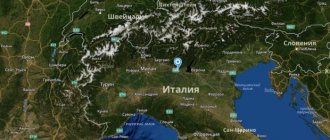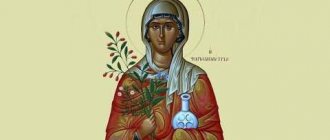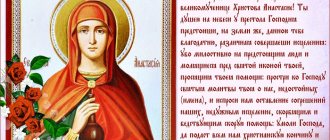Regarding the topic “Victoria’s Name Day according to the Orthodox calendar,” it should immediately be noted that in the Russian Orthodox Church there are no saints with the name Victoria in modern monthly calendars. However, this fact should not be understood in the sense that there are no such saints in the history of Orthodoxy. So when is Victoria’s name day celebrated? In the “Complete Monthly Book of the East” by Archbishop Sergius (Spassky), the four holy martyrs of Victoria are mentioned.
Victoria: angel day, name day
These are Victoria of Thessaloniki (June 1), Victoria of Ephesus (May 25), Victoria of Nicodemus (October 24) and Victoria of Kuluz (December 8). Digging deeper into the question of what date Victoria has her name day, it must be said that almost no information has been preserved about the life, time and martyrdom for faith in Christ of the first three Victorias. But there is presumptive evidence that they lived during the reign of the cruel emperors Trajan Decius or Diocletian.
To further expand the topic of “Victoria’s Name Day according to the Orthodox calendar,” it is worth adding that detailed information is known only about the holy martyr Victoria of Culuz (484), who suffered among many martyrs in persecution from the Arians in North Africa, when the vandal Huneric ruled there ( 477-484). This Vandal kingdom with its capital Carthage was formed in 439. The Goths converted the Vandals to Arianism, then, having settled in Africa, they began their bloody persecution of all Orthodox Christians who refused to join their church. And the persecution reached its most severe climax under King Gunerich.
The meaning of the name Nika
Translated from ancient Greek as “victory”.
from Greek [niko] – victorious. (Nike), the Greek goddess of victory, is depicted winged, with a wreath and a palm tree; identified with the Roman Victoria.
Holy Martyr Nike.
Saint Nike (Victoria) of Corinth suffered during the persecution of Christians in 251 under the emperor Decius in Corinth. The pagans threw her into the sea, but she did not drown, but walked on the water as if on dry land. The torturers caught up with her on the ship, hung a stone around her neck and drowned her.
Meaning and origin of the name Nika : victory
(Greek).
Energy and Karma of the name: Nika is a mobile and light name, but perhaps the combination of openness, brevity and some rigidity has a special meaning in it. Usually this leads to Nika reacting quite sharply to external influences, however, as a rule, her emotions do not reach too great a strength and do not leave a deep mark on her soul.
But Nika is very susceptible not to events in general, but specifically to the current moment. Life seems to pass through her, like a river through a narrow neck, and although almost no traces remain, this allows you to constantly feel its flow.
It’s even good that the emotions are not deep, maybe this indicates some superficiality of Niki, however, on the other hand, it does not cloud her mind, endowing her with a logical mindset and sufficient calm.
Moreover, under certain circumstances, when Nika is completely balanced, she can even sense the slightest changes in the course of life and, if she develops this ability in herself, then predict any events.
However, there is nothing supernatural in this; most people in the world could have such abilities, but usually a person is hampered by overwhelming feelings, everyday worries, worries about the future or painful memories.
It’s impossible to see the big picture behind this noise, because to do this you need to break away from your own thoughts and look at everything as a whole! Of course, for Nika, such “insights” are extremely rare, often she is simply hindered by some momentary grievances, but still, precisely because of this energy of the name, she has a good chance to at least develop her intuition, and at maximum (extrasensory abilities !
Otherwise, Nika does not stand out from the general environment in any way, except for her beautiful name. She is proud, although usually her pride is not painful, and in society she behaves quite calmly and confidently. In a word - the most ordinary woman with an ordinary fate, but with a rare ability in rare moments to see what; cannot be seen by a mere mortal.
Secrets of communicating with Nika. If today you quarreled with Nika, this does not mean that tomorrow she will still remember, so you shouldn’t worry too much, it’s better to just come up and offer peace. In general, if you don’t hurt her pride, it’s quite easy to communicate with her, especially for someone who has a sense of humor.
Astrological characteristics of the name Nika (see different horoscopes):
Zodiac sign: Aquarius.
Planet: Moon.
Name colors: brown, black silver. Most favorable color: blue.
Talisman stone: sapphire.
We celebrate name day: April 29 (April 16) - Nika, holy martyr.
Ancient Orthodox martyrs
It all started with the Arian bishops Cyril and Valinard, who convinced the king to get rid of the Orthodox Christians. At that time, a cruel fate befell all the noble Vandals who converted to the Orthodox faith. Roman officials who did not want to accept Arianism were exiled to the royal estates to work, the army that did not submit was dismissed from service and sent into exile to the mines of Sicily and Sardinia.
Archbishop of Carthage St. Eugene was imprisoned in a fortress, several bishops, priests and nuns were executed after monstrous torture. This event occurred in 482 on December 16th. At the same time, about 5,000 ordinary Orthodox people and priests, together with St. Felix of Abarite doomed them to death by starvation, expelling them into a lifeless desert, and some were sent into slavery to the barbarians.
Great and incomprehensible holiness
In 483, on July 2, monks from Capensa were martyred; there were seven of them, among them Saints Liveratius and Bonifatius. As a result, in order to completely destroy the Orthodox faith, Huneric convened all Orthodox bishops from the regions under his control (Sicily, Sardinia and North Africa) to arrange a dispute with the Arians. This happened on February 1, 484. After this meeting, Orthodox worship was completely prohibited on February 25, 484, and all the bishops were sent to hard labor, among whom were Saints Vigilius, Longinus, Pomarian, Vindemial, Cape and Archdeacon Octavius.
In the last months of his reign, Gunerich martyred 300 Orthodox people, two priests were sawn alive, 60 had their tongues cut out, but the Lord miraculously preserved their ability to speak.
From the Carthaginian martyrology such martyrs and martyrs became known as Dionysia of Vit with Majorik, Victoria (Nike) of Culuz, bishops Donatian of Bibiana, Laetius of Neptus, Servius of Tuburb, etc.; the doctor Liveratus, twelve young readers of Carthage and another twenty martyrs of Hadrumen.
Meaning and veneration in Orthodoxy
The relics of the martyr Nike were discovered in 1917, after the saints began to appear in the dreams of benevolent Christians living in their burial places. The relics of Victoria of Corinth are located within the walls of the nunnery, located on the banks of the Corinth Canal near Athens.
The bay, where the guards drowned Nike and other Christians, became a place of pilgrimage for believers. Arriving Christians plunge into the waters to receive God's grace. Saint Nike of Corinth is venerated on the day of remembrance of Codratus and his followers - March 23, and on the day of memory of the drowned Leonidas and female martyrs - April 29.
With their feat, Nika and the martyrs who died with her contributed to the spread of Christianity, proved the inviolability of the Orthodox faith, its purity and strength, which believers have remembered for many centuries and received the intercession of the saints before the Lord God.
Holy
And now we come to the most important thing, because it is not in vain that many are interested in the question of when Victoria’s name day is, because the life story of many martyrs is simply horrifying.
St. Victoria was from Kuluza (Kukuza). When the persecutors caught her, they forced her to renounce Orthodoxy, if only for the sake of her children. However, she was unshakable in the truth of her faith. Victoria was tortured for a long time, and finally it seemed to the tormentors that she had died. But a miracle happened, and the saint was healed, her lacerations healed and disappeared.
What about King Huneric? According to ancient legend, on December 8, 484, in a fit of madness, he bit himself. This news made Christians very happy, although his successors continued to persecute believers. However, on this day a cathedral holiday was established for the Orthodox martyrs who suffered from the vandals.
In modern calendars of the Russian Orthodox Church there is only the memory of the martyrs of 62 priests and 300 laymen who suffered from the Arians in 477 in Africa, which is also celebrated on December 8/21. If you look at the website of the Kiev-Pechersk Lavra, then in the calendar after the mark of African martyrs, the martyr Victoria of Kuza (Kuluz) is also indicated.
In addition to the four martyrs with the name Victoria, indicated by Archbishop Sergius in the “Complete Monthly Book of the East,” there are also other saints with this name known in the history of the ancient church. Most likely, they were not known about them in the Orthodox East, but they were revered in the Orthodox West until 1054.
Biography of the holy martyr
Not much is known about the earthly path of the Hieromartyr Nika (Victoria). The saint lived in the 3rd century, comprehended the teachings of the Lord under the mentorship of Elder Kodrat, adhering to Orthodox commandments in everyday life.
Origin
The events surrounding Nike and other Christians who followed the sermons of Saint Codratus unfolded in the Greek city of Corinth. It was in these places that the Apostle Peter preached two centuries earlier, who also addressed the local residents (Corinthians) with two messages.
Corinth was known as a large, populous and wealthy city. Most of its inhabitants were drowned in luxury and carnal pleasures, leading an immoral lifestyle. A future Christian was born in Corinth, who accepted torment in the name of the Lord God and became known to believers under the name Nika (Victoria) of Corinth.
At that time, paganism was widespread in the city, cultivated by its ruler. Christians were subjected to severe persecution and terrible public executions. But even in these terrible times, the followers of Orthodoxy did not deviate from God and consciously accepted torment for the sake of the holy faith.
Life and service to God
Saint Victoria was one of those wives who were not afraid to follow the Lord in an era of cruelty and violence against Orthodox believers. Nika, among other Christians, was a disciple of Saint Kodrat.
The elder was born to a persecuted Christian woman in the mountains near Corinth. The mother soon died after the birth of her son, but the baby, under the care of the Lord, was destined to survive. According to legend, the child was fed dew by a cloud falling from the sky.
Growing up, Kodrat, living in the desert, heard a Christian sermon and followed the teachings of the Lord. In an effort to help the suffering, he mastered the practice of medicine. Having strengthened his faith, Kodrat, who continued to live in the desert monastery, reflected on the Kingdom of Heaven, prayed to the Lord and began to read sermons.
Nika, along with like-minded people, often came to the desert, where she listened to the sermons of the elder, strengthening her faith more and more. One day, Victoria, along with other listeners, was tracked down by imperial guards led by the military commander Jason.
The detachment acted according to the orders of the ruling emperor Decius, who ardently promoted the pagan faith and declared a real hunt for adherents of Orthodoxy. In 250, the ruler signed a law on the extermination of all Christians. Kodrat and his students were arrested and thrown into prison.
Death and canonization
While in captivity, Nika and the Christians condemned by the worldly authorities were subjected to deprivation and torture. During brutal interrogations, Jason often turned to Kodrat as a mentor and leader of the followers and intercessors of Orthodoxy.
Believers were forced to renounce the Lord through physical pain and suffering, but all the martyrs were firm and adamant in their holy faith. Kodrat was tortured more than the others. The elder bravely endured the torment and consoled the others. Not a single Orthodox disciple renounced God.
Like the rest of the Christians convicted by the emperor, Victoria was sentenced to death. They dealt with prisoners in barbaric ways. Believers in Christ were tied to chariots and stones were thrown at them, but they bravely accepted the torment. Nika, along with other women convicted of Orthodoxy and the head of the women's spiritual chapel Leonid, was sentenced to drowning.
Nika and other martyrs were thrown into the waters of the Ionian Sea, but the Christians did not drown, but walked on the surface of the waters, chanting the Lord God. Not believing their eyes, the executors of the sentence caught up with the followers of Christ, threw stones around their necks and drowned them in the sea.
The drowned bodies of the martyrs, among which was Nika’s body, washed ashore, and were soon discovered by local residents. The bodies of the murdered righteous were buried. Later, Christians erected an Orthodox church over the grave of the holy martyrs. All the disciples who suffered torment with Kodrat were elevated to the rank of saints.
Ancient Latin martyrologies
There is also information about the sister martyrs Anatolia and Victoria of Rome, who suffered during the persecution of Decius. They were pagans, and they had suitors Titus Aurelius and Eugenius, but the girls suddenly changed their minds and wanted to devote their lives to Jesus Christ. The suitors tried to persuade them, but could not do anything, and then they were executed. There is a legend that even during the life of St. Victoria, in the name of the Lord, expelled the dragon that lived in one cave, which was attacking people and animals.
The martyrs suffered near the village of Sant'Anatolia (Italy). In the ancient Latin martyrologies they are mentioned by St. Alhelm (late 7th century). In addition, these martyrs are depicted in the famous mosaics of the church of Sant'Apollinare Nuovo in Ravenna (VI century). Memory of St. Victoria - December 23, St. Anatolia - July 9.
And there was also such a holy martyr Victoria the servant who suffered along with her master, the holy martyr Edistus (c. 60), when Nero reigned. Saint Edist was converted to Christianity by the Apostle Peter himself. In the 7th century in Italy, information was known about the monastery of St. Edistus, where the relics of him and St. Victoria were kept. Their memory is honored on October 12.
Victoria Kordubskaya
It is also necessary to mention the name of Saint Victoria of Corduba (Cordova) and her brother Acisclus. In 2011, in liturgical practice, for the first time in Orthodoxy, these names of martyrs of the first centuries of the formation of Christianity were included in the calendar. They were martyred in 304 in the city of Cordoba (Spain) during the reign of Diocletian. November 17 (30) is their memorial day.
Well, perhaps, we can finish the topic of “Victoria’s Name Day,” although this is not the entire list of saints with this name who did not spare their lives for the sake of true faith in Christ.




